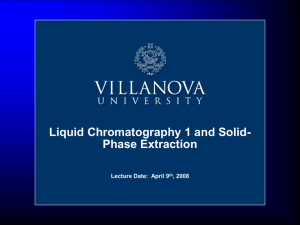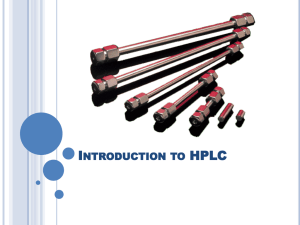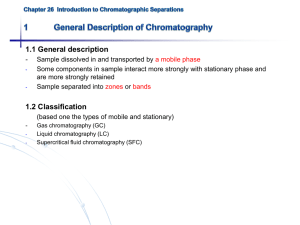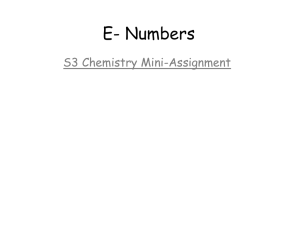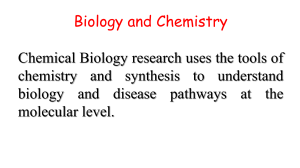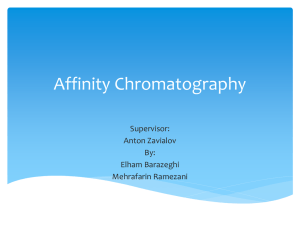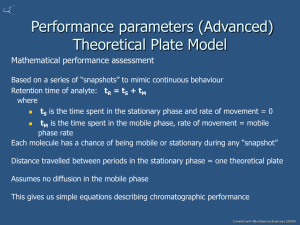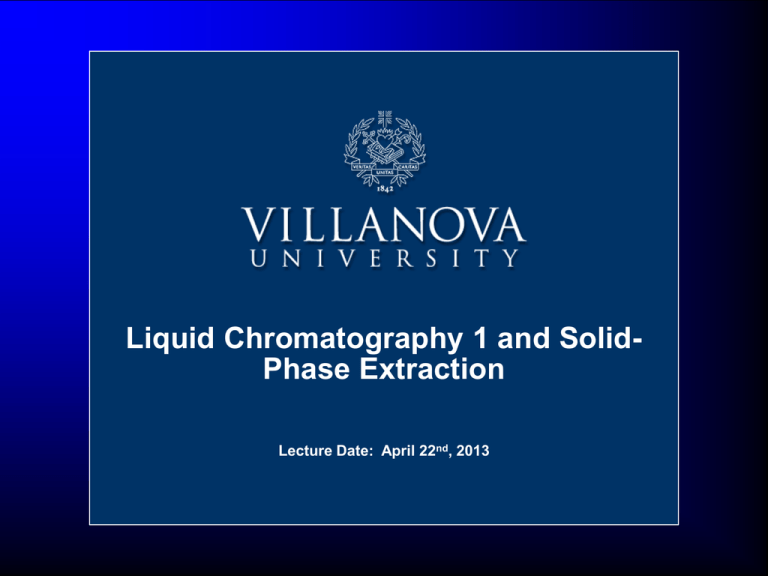
Liquid Chromatography 1 and SolidPhase Extraction
Lecture Date: April 22nd, 2013
Basic LC Terminology and Separation Modes
● Adsorption chromatography
• The stationary phase is an adsorbent (like silica gel or any other
silica-based packing)
• The separation is based on repeated adsorption-desorption
steps.
● Normal-phase chromatography
• The stationary bed is strongly polar in nature (e.g., silica gel),
and the mobile phase is nonpolar (such as n-hexane or
tetrahydrofuran).
• Polar samples are retained on the polar surface of the column
packing longer than less polar materials.
● Reversed-phase chromatography
• The stationary bed is nonpolar (hydrophobic) in nature.
• The mobile phase is a polar liquid, such as mixtures of water
and methanol or acetonitrile.
• The more nonpolar the material is, the longer it will be retained.
Basic LC Terminology and Separation Modes
● Size exclusion chromatography (SEC)
• The column is filled with material having precisely controlled
pore sizes, and the sample is simply sieved or filtered
according to its solvated molecular size.
• Larger molecules are rapidly washed through the column;
smaller molecules penetrate inside the pores of the packing
particles and elute later.
• Also called gel permeation chromatography (GPC)
although the stationary phase is not restricted to a "gel"
● Ion-exchange chromatography (IC)
• The stationary bed has a charged surface of opposite charge
to the sample ions.
• Used almost exclusively with ionic or ionizable samples.
• The stronger the charge on the sample, the stronger it will be
attracted to the ionic surface and thus, the longer it will take
to elute
• The mobile phase is an aqueous buffer, where both pH and
ionic strength are used to control elution time
Analytical Applications of LC
The “branches” of the LC family:
Note – this means analyte polarity
Basic Mechanisms in LC Separations
High Performance Liquid Chromatography (HPLC)
●
HPLC utilizes a high-pressure liquid mobile phase (ca.
100-300 bar) to separate the components of a mixture
●
These analytes are first dissolved in a solvent, and then
forced to flow through a packed small-particle
chromatographic column, where the mixture is resolved
into its components
●
HP = high pressure and high performance
● Resolution depends upon the extent of interaction
between the solute components and the stationary
phase
Differences between HPLC and “Classical” LC
Small ID (2-5 mm), reusable stainless steel columns
Column packings with very small (3, 5 and 10 m)
particles and the continual development of new
substances to be used as stationary phases
Relatively high inlet pressures and controlled flow of the
mobile phase
Precise sample introduction without the need for large
samples
Special continuous flow detectors capable of handling
small flow rates and detecting very small amounts
Automated standardized instruments
Rapid analysis
High resolution
From now on, LC refers to HPLC
Advantages and Disadvantages of LC
Advantages:
• Speed (minutes)
• High resolution
• Sensitivity
• Reproducibility
• Accuracy
• Automation
Disadvantages:
• Cost
• Complexity
• Low sensitivity for some compounds
• Irreversibly adsorbed compounds not detected
• Co-elution difficult to detect
More on Reversed-phase (RP) LC
RP is the most widely used mode of HPLC (75%?)
Separates molecules in solution on basis of their
hydrophobicity
– Non-polar stationary phase
– Polar mobile phase
In practice: non polar functional group bonded to silica
– Stationary phase
functional group bonded to silica
this corresponds to a volume (Van deemter)
Alkyl groups ( C4, C8, C18)
retention increases exp. with chain length
Mobile Phases
– Polar solvent (water) with addition of less polar solvent (acetonitrile
or methanol)
The Packed Column and the Stationary Phase
Packed LC columns, usually made of stainless steel and
carefully filled with material, are the heart of the LC
experiment
The stationary phase fills the column – its properties are
critical to the separation
Review of Molecular Interactions
The basis of separations (and most of chemistry)…
Name
Energy (kcal/mol)
Description
Covalent
100-300
Hold molecules together, orbital
overlap
Ionic
50-200
Electrostatic attraction
Polar
• Hydrogen bonding
• Dipole-dipole
• -stacking
3-10
Vary from electrostatic-type
interactions (e.g. hydrogen
bonds) to much weaker
Non-Polar
• Van der Waals
(dispersion)
1-5
Weak, induced dipole
Retention Mechanisms in LC
● LC is a dynamic partition/adsorption process. Analyte molecules, while
moving through the porous packing bead, tend to interact with the
surface adsorption sites or partition. Depending on the LC mode,
different types of the adsorption “forces” may be involved in the retention
process
● Hydrophobic interactions are the main ones in reversed-phase
separations (partition LC)
● Dipole-dipole (polar) interactions are dominant in normal phase mode.
● Ionic interactions are responsible for the retention in ion-exchange
chromatography.
● Retention in LC is competitive:
● Analyte molecules compete with the eluent molecules for the
adsorption sites. So, the stronger analyte molecules interact with
the surface, and the weaker the eluent interaction, the longer
analyte will be retained on the surface.
Elution Order in LC
Remember the elution order!
Elution order in normal-phase vs. reversed-phase LC:
Physical Properties of Stationary Phase Particles
HPLC separations are based on the surface interactions,
and depends on the types of the adsorption sites (surface
chemistry). Modern HPLC adsorbents are the small rigid
porous particles with high surface area.
Key parameters:
• Particle size: 3 to 10 µm
• Particle size distribution: as narrow as possible, usually within 10%
of the mean
• Pore size: 70 to 300 Å
• Surface area: 50 to 250 m2/g
• Bonding phase density (number of adsorption sites per surface
unit): 1 to 5 per 1 nm2
The Most Popular Particle: Silica
Different morphology for different applications:
Macroporous spherical silica particle. [K.K.Unger,
Porous silica, Elsevier, 1979]
Electron microphotograph of spherical and irregular silica particles. [W.R.Melander, C.Horvath,
Reversed-Phase Chromatography, in HPLC Advances and Perspectives, V2, Academic Press, 1980]
Different chemistry:
OH
H
Si
OH
Si
OH
Si
O
H
Free Silanol
Adsorbed Water
OH
Si
Si
O O
O
Si
Si
O
H
O
H
Geminal Silanol
Dehydrated
Oxide Siloxane
Bound and
Reactive
Silanols
Chemical Modifications to Silica
Silica (or zirconia, or alumina) by itself cannot do the job needed by
modern LC users – it must be functionalized and modified to suit the
analytical problem
Functionalized
groups
Residual
silanols
Si
Si
OH
O
Si
Si
O
Si
OH
O
Si
O
OH
O
O
Si
OH
Si
Diagram from Crawford Scientific
O
Si
O
Si
O
Chemical Modifications to Silica
Groups are usually attached via reaction
of an organosilane (which can be prepolymerized in solution)
Besides attaching groups, it is also
possible to polymerize the silica (or the
attached group)
Purpose: stability at low pH, more
coverage
– High-carbon load
Monomeric phases are more
reproducible (easier reactions to control)
– Monomeric phases are also known
as “sterically-protected”
Endcapping: fully react the silica
surface, remove silanols and their
acidity, more coverage
Diagram from K. A. Lippa et al., Anal. Chem.2005, 77,7852-7861
Common LC Stationary Phases
Name
Structure
Silica
Si
Propyl
Si
C8
Si
OH
Description
Normal phase, for separating polar, non-ionic
organics
C3H7
Reversed-phase, for hydrophobic interaction
chromatography (proteins, peptides)
C8H17
Reversed-phase, like C18 but less retentive,
used for pharmaceuticals, steroids,
nucleotides
Reversed-phase, retains non-polar solutes
strongly. When bonded to 300A silica can be
used for large proteins and macromolecules
C18
Si
C18H37
Cyano
Si
CH2CH2CH2CN
Reversed-phase and normal-phase, more
polar than C18, unique selectivity
CH2CH2CH2NH2
Reversed-phase, normal-phase, and weak
anion exchange. RP used to separate
carbohydrates
Amino
Si
Common LC Stationary Phases
Name
Structure
Phenyl
Diol
Si
Description
CH2CH2CH2
Reversed-phase, retains aromatic
molecules. Also used for HIC
(proteins)
O
Both reversed-phase and normalphase utility. Used for RP SEC,
also used for NP separations as a
more robust alternative to silica
(not ruined by trace water)
Si
OH
OH
Nitro
Si
NO2
Normal-phase, separates aromatic
and alkene-containing molecules
Polar Stationary Phase Interactions
In te ra ctio n s
S o rb e n ts
O
H
CN
Si
D ip o le / D ip o le
C
N
NH2
H
H
H
Si
2OH
H y d ro g e n B o n d in g
N
Si
O
O
O
O H
H
H
O
Source: Crawford Scientific.
H y d ro g e n B o n d in g
Ionic Stationary Phase Interactions
Sorbents
Interactions
H3+N
PRS
SO3-
Si
CBA
O
Si
H3+N
Si
Electrostatic
O-
-O S
3
SAX
Electrostatic
N+(CH3)3
Source: Crawford Scientific.
Electrostatic
Non-Polar Stationary Phase Interactions
S o rb e n ts
In te ra ctio n s
Si
va n d e r W a a ls
C8
Si
PH
C2
va n d e r W a a ls
Si
va n d e r W a a ls
Source: Crawford Scientific.
A Good Choice of Stationary Phase Depends on
the Analyte
F u n c tio n a lity
A n a lyte
M e c h a n is m
N
NH
H22
H yd ro p h o b ic
N o n -P o la r
N
NH
H22
H -B o n d in g
P o la r
+
+
N
NH
H33
Io n ic
Io n -E x c h a n g e
Source: Crawford Scientific.
More Subtle Effects
Shape selectivity (correlates with stationary phase order), temperature,
coverage (and the role of bonding chemistry):
Diagram from K. A. Lippa et al., Anal. Chem.2005, 77,7852-7861
More Subtle Effects
The effects of
temperature on the
order of the stationary
phase are often
surprising:
Diagram from K. A. Lippa et al., Anal. Chem.2005, 77,7852-7861
Normal Phase Chiral LC
Interactions between chiral analytes (enantiomers and
molecules with more than 1 chiral center) and chiral
stationary phases are also possible
Normal-phase is most common because of binding modes
A. Berthod, “Chiral Recognition Mechanisms”, Anal. Chem. 78, 2093-2099 (2006).
Chiral Stationary Phases
Interactions between chiral analytes and chiral stationary
phases are also possible.
Common chiral stationary phases:
Name
Chiral Recognition Mechanism
Analyte and Mobile Phase
Requirements
Protein based
Hydrophobic and electrostatic
interactions
Analyte must ionize, helpful if it
contains an aromatic. RP only.
Cyclodextrin
Inclusion complexation, H-bonding
Polar and aromatic groups, RP
and NP.
Polymerbased
carbohydrates
Inclusion interactions, attractive
interactions
H-bonding donors/acceptors, steric
bulk at chiral center, RP and NP.
Pirkle
H-bonding, interactions, dipoledipole interactions
H-bonding donor/acceptors, mostly
NP.
Adapted from L. R. Snyder, J. J. Kirkland, and J. L. Glajch, “Practical HPLC Method Development”, 2nd Ed., Wiley, 1997. Pg 545.
A Chiral LC Separation
Example: separation of
naproxen enantiomers
Chiral AGP column
– AGP = 1-acid glycoprotein
(orosomucoid), 181 amino
acid residues and 14 sialic
acid residues
Isocratic (no change in mobile
phase composition during
separation)
(S)
HO
O
O
(S)-naproxen
(R)
HO
O
O
(R)-naproxen
Adapted from L. R. Snyder, J. J. Kirkland, and J. L. Glajch, “Practical HPLC Method Development”, 2nd Ed., Wiley, 1997. Pg 545.
Hydrophilic Interaction LC (HILIC)
HILIC is NPC but is partition chromatography (not
adsorption/desorption) – it uses higher organic levels and special
columns.
HILIC uses a hydrophilic SP and an aqueous-polar organic solvent
MP.
HILIC allows retention of compounds that are poorly retained by
RPLC (see below).
In HILIC, a fraction of the MP becomes an integral part of the SP
because a water-enriched liquid layer is established within the SP. A
great variety of SPs are now available.
J. Sep. Sci. 2010, 33, 698–715
Ion Chromatography (IC)
Form of LC, also known as ion-exchange chromatography
Basic mechanism is electrostatic exchange:
Source: Rubinson and Rubinson, Contemporary Instrumental Analysis, Prentice Hall Publishing.
Typical IC Results
Example: an isocratic method for
monovalent cations in ammonium
nitrate based explosives
Detection limits 50-100 ppb, max
working range 40 ppm
Method:
– Sample Loop Volume: 50 µL
– Columns: IonPac® CS3 Analytical,
IonPac CG3 Guard
– Eluent: 25 mM HCl, 0.1 mM DAP•HCl,
4% Acetonitrile
– Eluent Flow Rate: 1.0 mL/min
– Suppressor: Cation MicroMembrane™
– Suppressor (CMMS)
– Regenerant: 100 mM
Tetrabutylammonium Hydroxide
– Detector: Conductivity, 30 µS full
scale
– Injection Volume: 50 µL
From Dionex Application Note 121R
Mobile Phases in LC
The type and composition of the mobile
phase (eluent) is one of the variables
influencing LC separations
Desirable properties:
– Purity
– Detector compatibility
– Solubility of the sample
– Low viscosity
– Chemical inertness
– Reasonable price
Mobile phases differ for each LC mode
Figure from Phenomenex technical literature
– Normal phase solvents are mainly nonpolar
– Reversed-phase eluents are usually a mixture of water with some
polar organic solvent such as acetonitrile.
Size-exclusion LC has special requirements for mobile phases
– Must dissolve polymers
– Must also suppress all possible interactions of the sample molecule
with the surface of the packing material
Control of Eluent Polarity
Isocratic elution: the eluent composition remains constant
as it is pumped through the column during the whole
analysis.
Gradient elution: the eluent composition (and strength) is
steadily changed during the run.
% mobile phase
Rs
Rs
N 1 1 k
4 k
*
N 1 1 k
*
4 k
time
where k* is the k at the midpoint of the column
LC Instrumentation
Pumps, Mixers
and Injectors
Column
Detector(s)
Computer
LC Instrumentation
The Agilent 1100, a typical modern LC system
Solvent reservoirs
Solvent degasser
Pump
Autosampler
Column oven
DAD
Review: The Purpose of Key LC Components
column
•separation chemistry
tubing to detector flow cell
•signal transduction
•amplification/scaling
•filtering
detector
analog output
•data acquisition
•digitization
A/D
digital output
chromatogram
•digital processing
•data analysis
The LC Pump(s)
Modern pumps have the following parameters:
Flow rate range: 0.01 to 10 ml/min
Pressure range from 1-5,000 psi
Pressure pulsations : less than1 %
Types of Pumps
Constant pressure pumps
Constant flow pumps
Reciprocating Piston Pump (90% of HPLC’s)
small internal volume
pulsed flow
Syringe type pumps (Displacement Pumps)
limited solvent capacity
Pneumnatic Pumps (pressure)
Temperature Control in LC
Thermoelectric heating/cooling
– the ability of a surface to
produce or absorb heat
when current is applied
across the junction of two
dissimilar conductors or
semiconductors
The effect can be reversed (i.e.
heating turned to cooling) by
reversing the DC current
through the junction
Also known as the Peltier effect
after its 1834 discoverer, a
French watch maker
Overview of LC Detectors
Common HPLC detectors
– Refractive Index
– UV/Vis
Fixed Wavelength
Variable Wavelength
Diode Array
– Fluorescence Detector
Less common:
– Conductivity
– Mass-spectrometric (LC/MS)
– Evaporative light scattering (ELSD)
Desirable Features of an LC Detector
1. Low drift and noise level
2. High sensitivity (ability to discriminate between
small differences in analyte concentration)
3. Fast response
4. Wide linear dynamic range
5. Low dead volume
6. Cell design that eliminates remixing of separated
bands
7. Insensitivity to changes in types of solvent, flow
rate, temp
8. Operational simplicity and reliability
9. Non-destructive
Baseline Noise and Drift
Detector Response
The definition of detector response depends on whether
it is mass sensitive or concentration sensitive
Mass sensitive mV/mass/unit time
R = hw/sM
Concentration sensitive mV/mass/unit volume
R = hwF/sM
h = peak height mV
W = width at .607 of height
F = flow rate
M = mass of solute
s = chart speed
UV/Visible Spectroscopic Detectors
A chemical compound could interact with the UV light. A beam of the electromagnetic
radiation passed through the detector flow-cell will experience some change in its intensity
due to this interaction.
infrared (IR)
2,500 - 50,000 nm
near infrared
800 - 2,500 nm
visible
400 - 800 nm
ultraviolet (UV)
190 - 400 nm
Name
Chromophore
Wavelength [nm]
Molar extinction, e
acetylide
-C=C
175-180
6,000
Aldehyde
-CHO
210
1,500
amine
-NH2
195
2,800
azo
-N=N-
285-400
3-25
bromide
-Br
208
300
carboxyl
-COOH
200-210
50 - 70
disulphide
-S-S-
194
5,500
ester
-COOR
205
50
ether
-O-
185
1,000
ketone
>C=O
195
1,000
nitrate
-ONO2
270
12
nitrile
-C=N
160
-
nitrite
-ONO
220 - 230
1000-2000
nitro
-NO2
210
strong
Flow Cell Design
Things to note:
parallel light beam
flow cell volume <1/10 of peak volume
optimization of cell geometry
Fixed / Variable Wavelength Detectors
Mercury vapor lamps emit very intense light at 253.7
nm. By filtering out all other emitted wavelengths,
manufacturers have been able to utilize this 254 nm
line to provide stable, highly sensitive detectors
capable of measuring subnanogram quantities of
any components which contains aromatic ring. The
254 nm was chosen since the most intense line of
mercury lamp is 254 nm, and most of UV absorbing
compounds have some absorbance at 254 nm.
Diode Array Detectors
Diode array detectors can acquire all UV-Visible
wavelengths at once.
Advantages:
– Sensitivity
(multiplex)
– Speed
Disadvantages:
– Resolution
Figure from Skoog, et al., Chapter 13
Other Detectors
Fluorescence Detector
Electrochemical Detector
Evaporative Light Scattering
Putting it All Together: LC Method Development
The importance – without a good method:
– Co-elution can be missed
– Unable to detect/assay key components
Basic consequences of method changes:
Choosing an LC Approach
Goals of a separation:
– Resolution (Rs) > 1.5
– Short separation time (5-30 minutes)
– Good quantitative precision/accuracy
– Acceptable backpressure
– Narrow peaks
– Minimal solvent use
Overall Strategy
First select an
appropriate method
If LC is best, then
determine nature of
the sample
“Exploratory” RP
runs, i.e. fast simple
gradients with C18
phases, are usually
helpful in assessing
retention and polarity
Solid-phase Extraction (SPE)
What is SPE?
– The separation of an analyte or analytes from a mixture of
compounds by selective partitioning of the compounds
between a solid phase (sorbent) and a liquid phase (solvent)
Comparison with conventional liquid-liquid extraction (e.g.
the organic sep funnel approach):
– SPE: selective towards functional groups (better)
– LLE: selective towards solubility
– SPE: more choices because no miscibility (better)
– LLE: must avoid miscible solvents
– SPE: concentrates analytes (better)
– LLE: can concentrate analyte after stripping
The Typical SPE Process
Conditioning:
Equilibration:
solvates the sorbent
removes excess conditioning solvent,
matches with analytical conditions (prevents “shock”)
Column
Conditioning
Column
Equilibration
Sample
Application
Interference
Elution
Analyte
Elution
Solid-phase Extraction
Conditioning the cartridge:
Not conditioned
Conditioned
SPE cartridges have a range of chemistries that are often
similar to those of LC stationary phases, but are optimized
for adsorption/desorption
Solid-phase Extraction
Automated SPE systems for sample cleanup – the Spark
SymbiosisTM
Can be hyphenated
with LC, MS, NMR,
etc… or used as a
stand-alone sample
pretreatment
Images from www.sparkholland.com
Further Reading
● Skoog, Holler and Crouch: Ch. 28
● Cazes: Ch. 22, 26
For a detailed discussion of method development in LC:
– L. R. Snyder, J. J. Kirkland, and J. L. Glajch, “Practical HPLC
Method Development”, 2nd Ed., Wiley, 1997.
For recent advances in understanding gradient elution, see:
– P. Nikitas and A. Pappa-Louisi, Anal. Chem., 2005, 77, 56705677 (a new derivation of the equation of reversed-phase HPLC
gradient elution)

